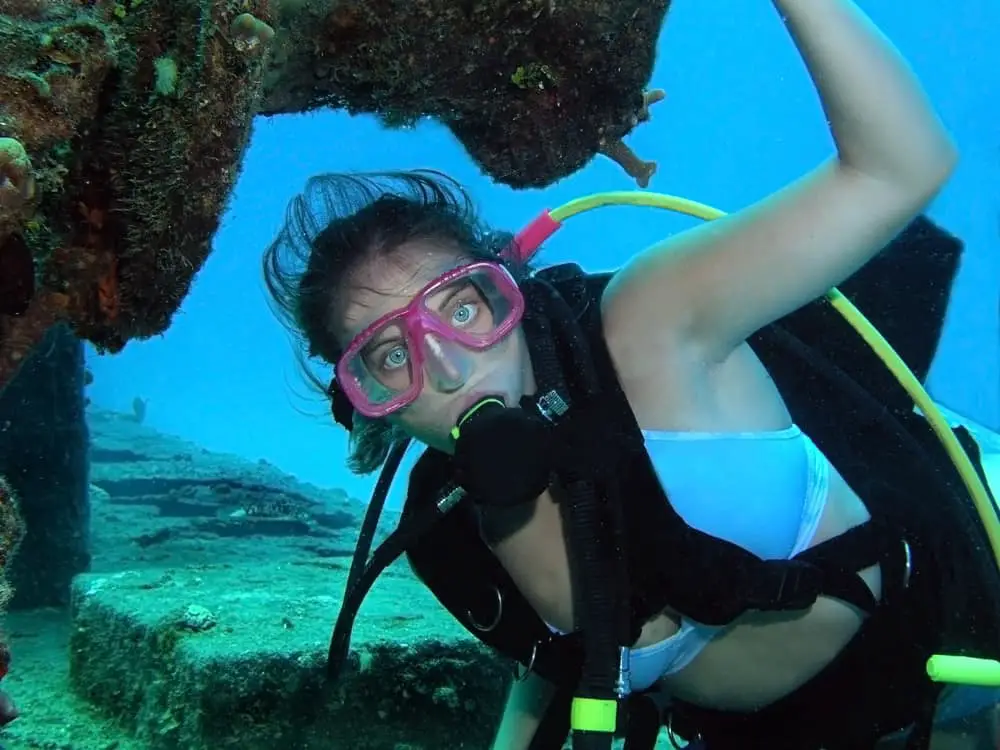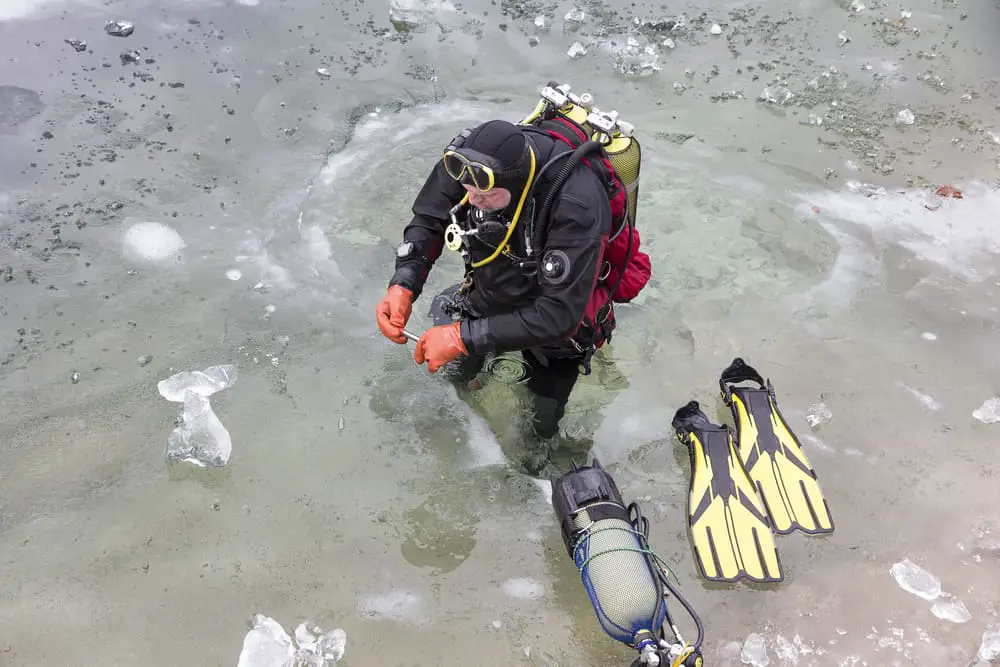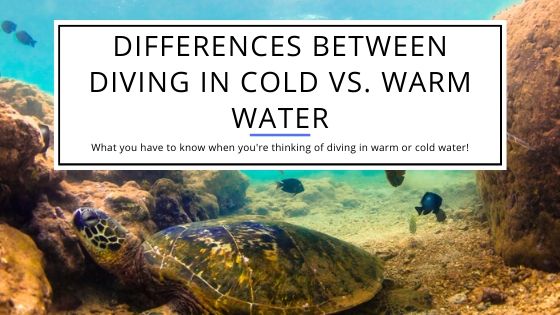Differences between Diving In Cold vs. Warm Water
Summer vacations on sandy beaches, palm trees in the wind, and colorful tropical fish – all these things come to mind when people think of scuba diving. Scuba diving is considered a summer activity where you can experience warm water and see vibrant schools of fish.
Destinations like Hawaii, Bali, and the Bahamas come to mind. People often dismiss places like Canada, Switzerland, Norway or Scotland as potential dive locations.
Cold water dives have a completely different experience to offer. Where you will see the expected tropical fish, turtles, groupers, and rays in warm water, you might be missing the chance to see some bucket-list-worthy marine life by skipping on cold water dives.
Coldwater marine life can range from sea lions to giant octopus and even sea dragons! And, of course, let’s not forget the wonderfully mysterious cold water wreck dives around the world.
Below we will discuss the differences between cold and warm water dives; from temperature, pressure, and equipment, here’s our detailed breakdown:
Is There A Difference Between Diving In Warm Water Compared To Cold Water?
Of course, a diver is going to experience the difference between diving into comfortable 85-degree water versus frigid 45-degree water. The body goes into shock as you plunge into cold water; you can experience muscle contraction, faster heartbeat, and heavy breathing, while warm water doesn’t have these effects on your body.
As stated earlier though, diving in cold versus warm water isn’t just about the temperature, the dives themselves are quite unique. You are exposed to different marine life in cold water, and also different sites. You might not get the colorful corals and tropical fish in cold water, but you might get the chance to explore the ins and outs of a historical shipwreck.
Cold and warm water dives also require different gear. This can have an effect on the dive as well. Something as simple as adjusting your mask can be a difficult task when you have gloves on; this is not a problem in warm water dives because, well, no gloves! You’re also going to wear a different suit, and have different regulators and buoyancy controls.
Let’s go deeper into these differences below.
Are Currents Different?
Currents don’t differ with temperature; instead, they depend on the type of water body, the location, and the weather. The main cause of water currents is the wind – most currents start in oceans and seas and are pushed toward smaller water bodies, such as rivers and streams.
Is Buoyancy Different?
Divers in cold water tend to be more buoyant. This is mainly because of their suit. Thicker suits and dry suits tend to be more buoyant because of their weight. Drysuits are filled with air to off-set the balance and some divers even choose to use steel tanks instead of aluminum to counter the buoyancy.
Divers that are going into cold water prefer to wear donut wing BCDs (Buoyancy Control Devices) over the traditional jacket style. The donut wing style gives divers more space for movement, which is harder with thicker suits, as it allows more weight to be carried.

Do You Need More Weight In Warm Vs Cold Water?
Since buoyancy is affected by the suit, more weight does need to be carried in cold water. This weight can be in the form of a regular weighted belt with steel weights, a steel backplate or then steel tanks instead of aluminum. Regardless, if you’re going cold water diving, be prepared to carry more weight.
Do You Need Different Dive Computer Settings?
Dive computers are a piece of equipment that divers use to get real-time information about their depth and dive time. It helps them determine how much dive time they have left and what their ascent time will be.
Some dive computers can read water temperature as well, but they can’t read internal body temperature. This means changing the settings would not help you much. Your dive computer settings need to be changed according to the dive rather than the temperature of the water.
What Different Marine Life Can You Expect Between Cold And Warm Water Diving?
Marine life can differ a great deal from warm to cold water, and even location to location. All warm water won’t have the same marine life and the same goes for cold.
Here are some of our favorite warm and cold water sites and the marine animals that you can find there:
Warm Water
- Dolphins in Cabo San Lucas
- Stingrays in the Grand Cayman
- Groupers in Florida
- A number of different sharks in the Bahamas
- Sea turtles in Costa Rica
- Manta Rays in Bali
Cold Water
- Pacific Octopus in British Columbia, Canada
- A number of different whales in Norway
- Sea lions in the Channel Islands
- Sea dragons in Southern Australia
- Neon-orange and fuchsia jewel anemones in New Zealand
- Arctic seals and penguins in Antarctica
Is Visibility Better In Warm Or Cold Water?
There are a number of different dive sites offered for both cold water and warm water dives. The visibility of the water varies from site to site rather than temperature. Divers strive to dive in waters with the most clarity; this factor usually depends on the body of water, time of day, current and outside weather.
Warm water dive sights in places like the Maldives, Cayman Islands, and Malaysia offer great visibility. On the other hand, cold water dives like those in Iceland and Norway have dazzling, crystal clear water that any diver would love to experience.

Do You Need Different Gear?
Cold water dives do require different gear. First and foremost, you need to get your exposure protection. You need to make sure your body does not go into shock when it touches the cold water, so layer up properly. Depending on the temperature of the water, you can opt for a 5mm wetsuit, a 7mm wetsuit, a semi-dry suit, or a dry suit.
On top of a thicker suit, invest in gloves, boots and a hood. Your body tends to lose heat from its extremities first; this includes your head, hands, and feet, so make sure they are properly covered.
Another important difference in gear is the regulator. You need to make sure that your regulator is suited for cold water. You don’t want it to freeze up in the cold temperatures; that could be very hazardous. The regulator should offer environmental seals to make sure there is no hiccup at the first stage.
Apart from that, as discussed above, extra weights, a different BCD and steel tanks may be required according to your preference.
Final Thoughts
Keep in mind that you need to stay warm before your cold water dive too! Loss of heat is a gradual process and starts before you enter the water. Once you are done with your dive, get out of your wet gear immediately, dry yourself off, and put on some dry clothes. Cover your head too, and try putting on something made of fleece to help absorb extra moisture and keep you warm.
Even though you might be tempted, avoid jumping straight into a hot shower as the rapid change in temperature can have adverse effects on your body. Instead, enjoy a hot drink of your choice and warm up within!

